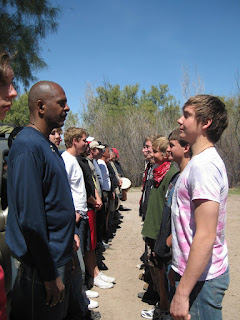After the recent blog post with a discussion of boys and Nature Deficit Disorder (NDD), Tim Wernette, a regular Man-Making Blog contributor, emailed me about Woodcraft Indians. In my research into that organization, I learned a lot more about the history of NDD. I also learned how, in the early 1900’s, one man's attempt to do something about boys and NDD resulted in the formation of the Boy Scouts, the Brownies, and the creation of a multitude of other organizations that are still helping kids a hundred years later.
The man was Ernest Thompson Seton. The full name for the organization he started was The League of Woodcraft Indians because they borrowed heavily from Native American culture, and their goal was to get young males into the woods. The organization was clearly for non-Indians, but it was very successful in getting American boys into the wilderness.
The first U.S. Woodcraft Tribe was set up in 1902. It was a direct result of Mr. Seton’s property being vandalized by neighborhood boys. As the story goes, after numerous repairs to his property, Mr. Seton went to the local school. Instead of looking to punish the young vandals, he invited them to a weekend campout on his property. During this time he told them about Native Americans and their connection to nature. He spoke about Native American language, lore, and culture. He taught them some basic wilderness skills, and I’ll bet some time was spent sitting around a fire and telling exciting stories of the then not-so-old west.
Out of this one weekend experience, The League of Woodcraft Indians evolved, and soon there were Woodcraft groups all across the United States. If you want to read a complete and detailed operating manual for a Woodcraft Indian group, take a look at Seton’s Birch Bark Roll (PDF document from the New York Public Library or this online version.)
If you don’t worry about political correctness and can allow for the era in which it was written, the Birch Bark Roll, in amazing detail, lays out the perfect template for a boy-literate organization. It describes the organizational structure with Native American names for the various positions. I especially love the chapters on, The Child Spirit of Woodcraft, Twelve Secrets of the Woods, Tribe and Council Activities (games), and even songs to sing around the campfire. Songs have titles like, Zuni Sunset Song, Ghost Dance Song, and a blessing song called, Prayer of the Warriors Before Smoking the Pipe, all with sheet music included!
While the details are complicated, in 1910, Mr. Seton, along with Daniel Beard, the man who had started The Sons of Daniel Boone, were instrumental in the founding of the Boy Scouts of America (BSA). Seton became the Chief Scout of the organization for its first five years. Because of disagreements about the more militaristic direction Seton felt Scouting was moving, he left the BSA in 1915 and re-established the Woodcraft Indians separately. Later he renamed his organization The Woodcraft League of America, and claimed he never really merged the group into the BSA.
Today, there are still Woodcrafters who are active in the movement. One of the better known groups in the U.S. might be the Woodcraft Rangers in Los Angeles, California. Established in 1922, this group modified Seton’s original emphasis on outdoor life and is working to support urban Los Angeles kids. Currently, the Woodcraft Rangers serves over 18,000 underprivileged youth annually in after-school and summer camping programs.
If you want to know more about the large and rather amazing web of international organizations launched by one man’s interest in what we now call Nature Deficit Disorder, and his willingness to show up for the boys in his hood, just do a Google search for Woodcraft Indians. The result of that search takes my breath away, but then I just love the, What One Man Can Do, stories.
LIKE: If you enjoy this blog, please click the "Like" button below to support the Man-Making Facebook page!
TWEET: Send this post along to your friends or follow me on Twitter!
SUBSCRIBE: If you're not yet a subscriber to the Man-Making Blog, and you'd like to receive these posts by email 3-4 times a month, go to this link for a free subscription.
CONTACT: Send Earl a message.




